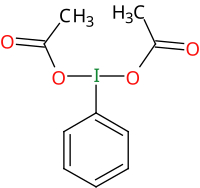Iodosobenzene diacetate
 |
|
| Names | |
|---|---|
|
IUPAC name
[acetyloxy(phenyl)-λ3-iodanyl] acetate
|
|
| Other names
Bis(acetoxy)(phenyl)iodane
Bis(acetato-O)phenyliodine Bis(acetoxy)iodobenzene (Diacetoxyiodo)benzene I,I-Diacetatoiodobenzene Iodobenzene diacetate Iodosobenzene I,I-diacetate Phenyliodine(III) diacetate (PIDA) Phenyliodo diacetate |
|
| Identifiers | |
|
3D model (JSmol)
|
|
| ChemSpider | |
| ECHA InfoCard | 100.019.826 |
| EC Number | 221-808-1 |
|
PubChem CID
|
|
|
|
|
|
| Properties | |
| C10H11IO4 | |
| Molar mass | 322.10 g·mol−1 |
| Appearance | white powder |
| Melting point | 163–165 °C (325–329 °F; 436–438 K) |
| reacts | |
| Solubility | soluble in acetic acid, acetonitrile, dichloromethane |
| Structure | |
| orthorhombic | |
| Pnn2 | |
|
a = 15.693(3) Å, b = 8.477(2) Å, c = 8.762(2) Å
|
|
| T-shaped molecular geometry | |
| Related compounds | |
|
Related compounds
|
(Bis(trifluoroacetoxy)iodo)benzene |
|
Except where otherwise noted, data are given for materials in their standard state (at 25 °C [77 °F], 100 kPa).
|
|
| Infobox references | |
(Diacetoxyiodo)benzene, also known as phenyliodine(III) diacetate (PIDA) is a hypervalent iodine chemical reagent with formula C
6H
5I(OCOCH
3)
2. It is used as an oxidising agent in organic chemistry.
(Diacetoxyiodo)benzene (PIDA) was originally prepared by Conrad Willgerodt by reacting iodobenzene with a mixture of acetic acid and peracetic acid:
PIDA can also be prepared from iodosobenzene and glacial acetic acid:
More recent preparations direct from iodine, acetic acid, and benzene have been reported, using either sodium perborate or potassium peroxydisulfate as the reducing agent:
The PIDA molecule is termed hypervalent as its iodine atom (technically a hypervalent iodine) is in its +III oxidation state and has more than typical number of covalent bonds. It adopts a T-shaped molecular geometry, with the phenyl group occupying one of the three equatorial positions of a trigonal bipyramid (lone pairs occupy the other two) and the axial positions occupied by oxygen atoms from the acetate groups. The "T" is distorted in that the phenyl-C to I to acetate-O bond angles are less than 90°. A separate investigation of the crystal structure confirmed that it has orthorhombic crystals in space group Pnn2 and reported unit-cell dimensions in good agreement with the original report. The bond lengths around the iodine atom were 2.08 Å to the phenyl carbon atom and equal 2.156 Å bonds to the acetate oxygen atoms. This second crystal structure determination explained the distortion in the geometry by noting the presence of two weaker intramolecular iodine–oxygen interactions, resulting in an "overall geometry of each iodine [that] can be described as a pentagonal-planar arrangement of three strong and two weak secondary bonds."
...
Wikipedia
